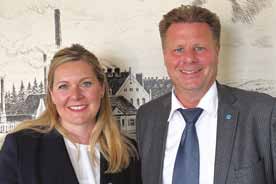Denise Caspar joined Mannesmann Stainless Tubes (MST) in April 2023, bringing with her 17 years of experience in the seamless pipe business. Now that she has had time to settle in, Heat Exchanger World was keen to hear her take on trends in this flourishing sector.
By Joanne McIntyre, Heat Exchanger World

“Based on continuously increasing technical demands and price volatility towards the equipment for processing units, the product performance and product cost have to be balanced,” begins Dipl.-Ing. Denise Caspar, Business Development Manager, CPI & Energy. “We should keep in mind that high-performance seamless stainless steel needs a certain amount of costly alloying elements to form it into high-performance products. The industry is calling for outstanding, flexible technology expertise, and from my perspective, a ‘good enough’ approach is, in many applications not purposeful. As a manufacturer, you can lay out your alloying approach in accordance with the minimum requirements defined by industry standards. Or, based on your strong industry knowledge, you can adapt realistic operation requirements to your product, which will then be overdesigned compared to the standards. However, the chemical processing industry (CPI) requires expertise to create an economical, reliable solution for an operating unit that has to stay flexible in the feed it processes.”
Denise continues, “A typical example is DMV 304L versus standard 304L (UNS S30403). Compared to the minimum standard requirements of ASTM, the alloying concept of DMV 304L typically presents 19% Cr and 11% Ni to comply with the realistic needs under operation.” “Highly aggressive environments in the CPI industry are screaming for consistent, corrosion- and temperature-resistant seamless stainless tubes, which should be “easy-to-weld”. The effort of mechanical cleaning operations, shutdowns and new integrity tests caused, e.g. by sensitisation and forming of secondary intermetallic phases in the microstructure of stainless tubes, need to be considered from the design stage.”
High-alloyed duplex
“High-alloyed duplex stainless tubes in DMV 29.7 support the main goals of the urea industry to operate in well-controlled maintenance periods and avoidance of unforeseen (major) shutdowns in different areas of operation units. Even in low oxygen environments, these duplex tubes present excellent resistance to several corrosion mechanisms, e.g. intergranular corrosion, pitting and crevice corrosion and stress corrosion cracking. Due to its highly sophisticated alloying concept and carefully-controlled heat treatment during tube production, all MST products show a well-balanced microstructure for the target application.”
Facing tough challenges
“We provide a high-quality concept combining clever alloying concepts, well-controlled raw material supplies, stable hot-extrusion and cold-finishing processes realising very tight dimensional tolerances to comply with the highest testing requirements,” continues Denise. “In different configurations, such as heat exchanger tubes, furnace tubes, piping or instrumentation tubes, MST products withstand extremely corrosive environments at high temperatures and pressures. DMV 200 pure nickel and DMV 400 nickel-copper alloy tubes are increasing reliability in desalination equipment, atmospheric rectification units and environments where units are exposed to alkali-chloride concentrations, vinyl chloride monomers and many others.” “Depending on the engineering design needed, we act to the guiding principle – where a customer identifies a challenge, we see an opportunity! Within our colourful bouquet of high-quality duplex, nickel, nickel-copper and austenitic seamless stainless tubes, we offer customised solutions for many different challenging industries.”
Low CO₂ footprint
MST tubes have a very low CO₂ footprint due to a large amount of high-class quality scrap the company uses to produce its raw materials. Circularity is a central focus in all its efforts to reduce greenhouse gas emissions to an absolute minimum.
Patrik Schraven, Head of Marketing, Business Development and R&D adds: “A typical case is phosphoric acid production where up to now brittle graphite tubes with dramatic issues during cleaning and maintenance are the industry standard. After years of cooperation with several phosphoric acid producers, DMV 4692 (NiFeCr27Mo6CuN) can replace graphite tube heat exchangers without compromises on the lifetime.”
Ready for the toughest environments

“Here at MST, we like to say that our products are like firemen; where others run away, we jump in!” smiles Denise. “Whether it’s a hot environment defined by highly aggressive naphthenic, sulfuric or hydrochloride acids matured from a crude oil refinery process, or ammonium carbamate solutions, syngas or nitric acids used in the fertiliser industry. Mannesmann stainless seamless tubes are designed for and have proven track records in these and many other challenging conditions. “Our products generate added value in terms of life duration in highly corrosive stressful environments, offer optimised weldability and finally are beneficial for the customer’s total cost of ownership.”

